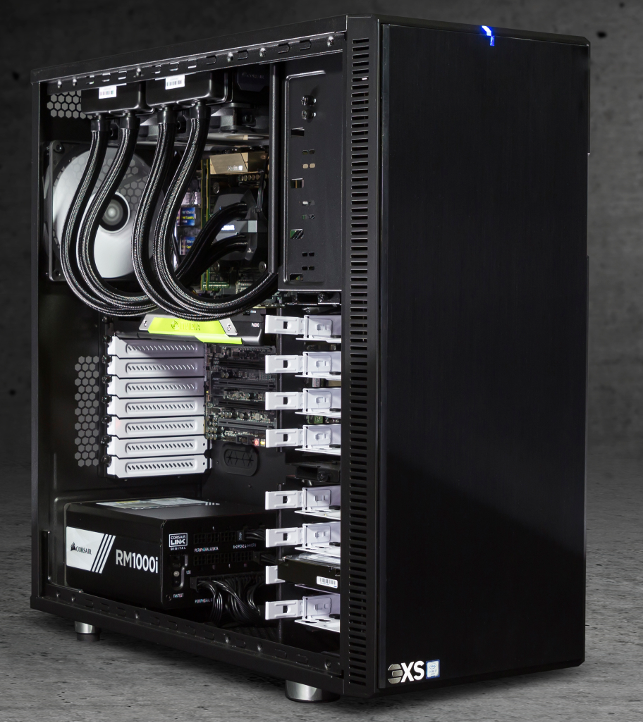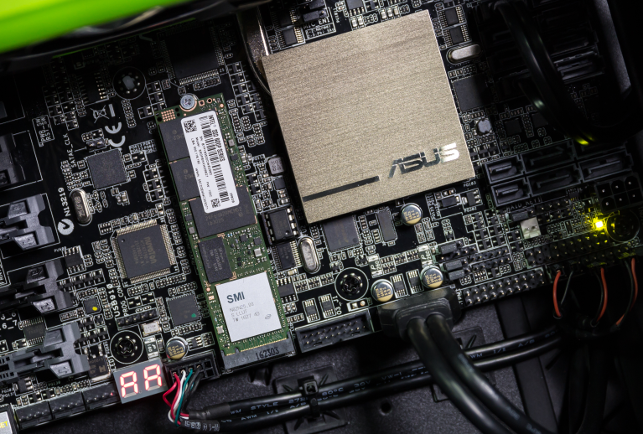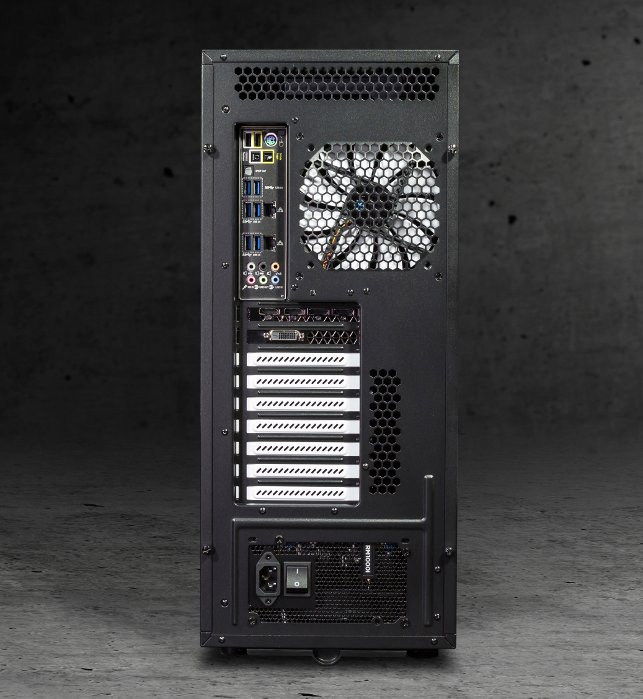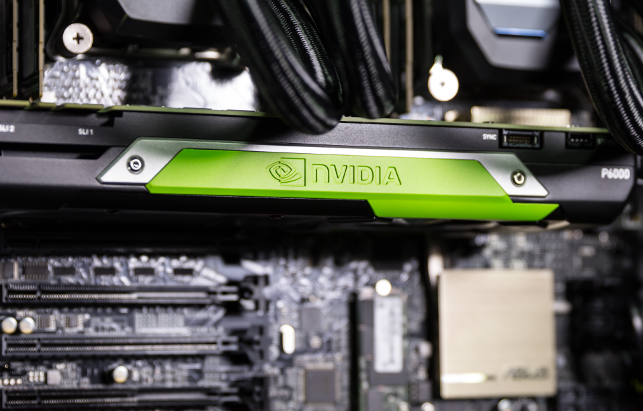Scan is renowned for its low cost, overclocked 3D CAD workstations. But this new machine from the Bolton-based manufacturer is a different beast altogether.

The Fractal Design Define XL R2 chassis is well over 0.5m tall
The Scan 3XS Ultimate 3D is a dual Xeon graphics workstation for those who take their design visualisation or Virtual Reality (VR) very seriously. It’s incredibly powerful, but the biggest workstation we have ever reviewed. With the Fractal Design Define XL R2 chassis measuring 232mm (w) x 559mm (h) x 560mm (d), this is definitely one to keep under your desk.
As you might expect, the price tag is also substantial, coming in at £9,583 + VAT. This might look like a lot but it is significantly less than what you’d pay for an equivalent machine from a Tier One manufacturer, such as Dell or HP.
The bulk of the budget goes on processors — a pair of Intel ‘Broadwell’ Xeon E5-2687W v4 CPUs and one ultra-high-end Nvidia Quadro ‘Pascal’ P6000 GPU.
The Xeon E5-2687W v4 is a special 160W workstation CPU which offers designers the best of both worlds – high frequency (3.0GHz up to 3.5GHz) for general application performance and lots of cores (12) to make light work of multithreaded calculations. It pretty much hits the sweet spot for most desktop viz workflows.
While ray trace rendering performance would likely be some way behind the 22 core Intel Xeon E5-2699 v4, our pair of Intel Xeon E5-2687W v4 CPUs were certainly no slouches when number crunching through our benchmarks. The 3XS Ultimate 3D is the
first machine to break the one minute barrier in our 3ds Max rendering test. It also set a record in Luxion KeyShot, completing our motorbike scene in 152 seconds.

The machine has support for one onboard M.2 NVMe SSD
The beauty of the 3XS Ultimate is it does all of this without breaking into a sweat. In fact, thanks to its capacious noiseabsorbing chassis and a pair of Corsair H80i hydrocoolers, the machine has very good acoustics, even when rendering for several hours — although fan noise is still quite noticeable when idle.
The Intel Xeon E5-2687W v4 CPUs might contribute to just over a third of the overall system cost, but it’s the 24GB Nvidia Quadro P6000 that really piles on the pounds. At £4,426 + VAT this Pascal-based dual height GPU is for the most demanding design visualisation and VR workflows.
Performance was exceptional in Autodesk VRED Professional. Our automotive test model hit 100 frames per second (FPS) at FHD resolution with Anti-Aliasing disabled. Notably, even when AA was set to ultra-high, it maintained 25 FPS, which is perfectly smooth for all but the most discerning eyes.
We had a similarly smooth experience in ‘game engine’ architectural design viz tool LumenRT, with the Quadro P6000 delivering anywhere from two to four times the performance of the Quadro M2000 (a popular 3D CAD GPU) with our GPU limited test models.
For Virtual Reality, the Quadro P6000 clocked in around 40% quicker than Nvidia’s other Pascal-based Quadro, the Quadro P5000, delivering a VRMark ‘Blue Room’ score of 65 FPS. This may be well off the target 109 FPS for smooth VR, but let’s not forget that this demanding benchmark is designed to test against future generation HMDs, rendering an extremely complex scene at a breathtaking 5,012 × 2,880 (5K) resolution.
Of course, the proof of the pudding is in the eating, so we put on an HTC Vive and tested the machine with two demanding architectural VR applications Autodesk LIVE and Enscape. The Quadro P6000 handled everything we threw at it and there was no hint of it dropping below the critical 90 FPS threshold which is needed for a comfortable VR experience.
In contrast, considering just how powerful the Quadro P6000 is, performance in 3D CAD tool SolidWorks was quite underwhelming. While we didn’t expect the Quadro P6000 to show any benefit over the Quadro M2000 when viewing models in shaded with edges mode (as this viewing mode is very CPU limited), we did expect the P6000 to pull away when RealView, shadows and Ambient Occlusion were turned on. But, to our surprise, this lead never materialised. In saying that, it should offer perfectly acceptable performance in all 3D CAD applications.
******************UPDATE 19/01/17*******************
Nvidia was also surprised with our SolidWorks results. SolidWorks 2015 SPECapc benchmark tests that it has carried out internally show the Quadro P6000 to be 65% faster when viewing models in Shaded with Edges mode using RealView and Shadows and Ambient Occlusion and 6% faster in Shaded with Edges mode. Nvidia’s test were carried out on a Windows 7 Professional workstation, whereas our Scan workstation was running Windows 10 Pro. We hope to give you more information as and when we have it.
******************UPDATE 19/01/17*******************
******************UPDATE 01/02/17*******************
Nvidia has now provided more information about performance in SolidWorks 2015.
SolidWorks uses an internal whitelist to determine if graphics cards support advanced shading methods. Pascal-based Quadro GPUs are not currently on the whitelist for SolidWorks 2015 SP5 so that would account for the reduced performance scores we saw.
Nvidia says that SolidWorks will release a patch on its product certification page soon. In the meantime, it supplied us with a simple regedit file that put Pascal GPUs on that whitelist.
We then re-tested the Quadro P6000 and got similar scores in the SPECapc SolidWorks 2015 benchmark to those of Nvidia.
Nvidia told us that Pascal Quadro GPUs are already on the whitelist for SolidWorks 2016 and 2017.
******************UPDATE 01/02/17*******************
Putting the Quadro P6000 to work inside GPU-accelerated physically based renderer, SolidWorks Visualize, told a different story. The Quadro P6000 produced a 100 pass FHD render in an incredible 21 secs and, even with 500 passes, the render completed in 84 secs. By getting results back so quick, this machine has the potential to change the way designers think about using physically-based rendering in their design workflows.
Importantly, using your GPU for rendering doesn’t have to interrupt your 3D modelling workflow. Even when rendering flat out in SolidWorks Visualize, we were still able to smoothly pan, zoom and rotate models in LumenRT, albeit at a reduced frame rate. This ‘multi tasking’ capability is down to ‘Pascal’s’ Async Compute / Dynamic load balancing technology, which is designed to more efficiently share GPU resources between graphics and compute tasks. With its predecessor, the ‘Maxwell’-based Quadro M6000, 3D models in LumenRT would likely have stuttered.
With 128GB of DDR4 ECC memory, our test machine is well equipped to handle extremely complex design viz datasets. Of course, the 3XS Ultimate 3D can be tuned, as required, from 64GB all the way up to 512GB.
For a machine of this stature, the storage feels a little pedestrian – specifically the choice of the 256GB Intel 600p NVMe SSD (1,570MB/s read, 540MB/s write, 112K IOPS) as the primary drive. An additional £13 would get you the 256GB Samsung SM961, which, with up to 3,100MB/s read, 1400MB/s write and 330K IOPS, boasts more than double the performance of the Intel drive. This could make a big difference when handling large design viz datasets or video. Capacity can also be increased with several different M.2 NVMe options available, all the way up to the 2TB Samsung 960 Pro.
With only one M.2 slot on the Asus Z10PE-D16 WS motherboard, it’s not possible to add a second M.2 NVMe drive. However, if high-performance storage is important, Scan offers optional Intel 750 PCI-E NVMe SSD add in cards, in capacities of 400GB or 1.2TB. With eight 3.5-inch drive bays, and only one taken by a 2TB Seagate Barracuda Hard Disk Drive (HDD), there’s plenty of scope to boost storage capacity with a host of 2.5-inch SATA SSDs (up to 1TB) and 3.5-inch HDDs (up to 6TB).

3 The Xeon CPUs are liquid cooled to help keep fan noise down. 4 Nvidia Quadro P6000 GPU. 5 Eight drive bays for 2.5-inch or 3.5-inch SATA drives. 6 1000W PSU
Conclusion
It’s hard not to fall for the Scan 3XS Ultimate 3D, simply because of the sheer power it possesses. From stunning 3D performance (in or out of VR) and plenty of muscle for both CPU and GPU rendering, this giant tower workstation can accelerate 3 all different design viz workflows.
The machine is well built and quiet – the liquid cooling and insulated chassis a big plus. The downside is size, which is significantly larger than comparative machines from the likes of Dell, HP and Lenovo. But this could be a small cross to bear considering it’s significantly cheaper.
In summary, if you are pushing the boundaries of design viz and need a wellbalanced machine for CPU and GPU centric workflows then the 3XS Ultimate 3D is well worth a look. Those on a tighter budget might consider downgrading to the Quadro P5000. It might not hit the heights of the fl agship P6000 but it’s still an excellent GPU for viz and VR and will bring the machine cost down to £6,756 + VAT.




Specifications
» 2 x Intel Xeon E5 2687W v4 CPU (12 cores) (3.0GHz, 3.5GHz Turbo)
» 128GB (8 x 16GB) Samsung ECC Registered DDR4 2400MHz memory
» 256GB Intel 600p NVMe M.2 PCIe SSD + 2TB Seagate Barracuda HDD
» Nvidia Quadro P6000 (24GB GDDR5X) GPU (375.63 driver)
» Microsoft Windows 10 Pro 64-Bit
» 232mm (w) x 559mm (h) x 560mm (d)
» 3 Years – 1st Year Onsite, 2nd and 3rd Year RTB (Parts and Labour)
2 x Intel Xeon E5 2687W v4 CPU (12 cores) (3.0GHz, 3.5GHz Turbo)
128GB (8 x 16GB) Samsung ECC Registered DDR4 2400MHz memory
Nvidia Quadro P6000 (24GB GDDR5X) GPU (375.63 driver)
256GB Intel 600p NVMe M.2 PCIe SSD + 2TB Seagate Barracuda HDD
3 Years – 1st Year Onsite, 2nd and 3rd Year RTB (Parts and Labour)
N/A
N/A
N/A
N/A
N/A
N/A
N/A






